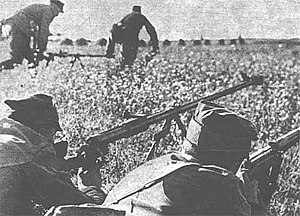PTRD-41
| PTRD | |
|---|---|
 A PTRD. | |
| Type | Anti-tank rifle |
| Place of origin | |
| Service history | |
| In service | 1941–? |
| Used by | Soviet Union, North Korea, China |
| Wars | World war II, Korean War, Chinese Civil War |
| Production history | |
| Designer | Vasily Degtyaryov |
| Designed | 1941 |
| Manufacturer | Degtyaryov plant |
| Produced | 1941–1945 |
| Specifications | |
| Mass | 17.3 kg |
| Length | 2,020 mm |
| Barrel length | 1,350 mm |
| Crew | 2 |
| Cartridge | 14.5x114mm |
| Action | Single-fire |
| Rate of fire | 6-8 rounds/min |
| Muzzle velocity | 1,012 m/s (3,319.3 ft/s) |
| Effective firing range | 400 m |
| Maximum firing range | 800 m |
| Feed system | Single shot, no magazine |
| Sights | Front post, rear notch |
The PTRD-41 (Shortened from Russian, ProtivoTankovoye Ruzhyo Degtyaryova) was an anti-tank rifle produced and used from early 1941 by the Soviet Red Army during World War II. It was a single-shot weapon that fired 14.5x114mm tungsten core rounds. Although unable to penetrate the frontal armor of German tanks, it was effective against the thinner sides of early-war German tanks and self-propelled guns. The 14.5 mm armor-piercing bullet had a muzzle velocity of 1012 m/s. It could penetrate an armor plate up to 35 to 40mm thick at a distance of 100 meters. During the initial invasion, and indeed through-out the war, most German tanks had side armor thinner than 40mm [PzKpfw I & II 13-20mm, III & IV series 30mm, PzKpfw V Panther 40-50mm].
In 1939 the USSR captured several hundred Polish Model 35 anti-tank rifles, which proved effective in the September Campaign. Vasily Degtyaryov used its copied lock and several features of German Panzerbüchse 38 when hasty construction of an ATR was ordered in July 1941.
The PTRD and the similar PTRS-41 were the only individual anti-tank weapon available until the arrival of Lend-Lease bazookas from the USA later in the war[citation needed]. PTRD users would attempt to hit weak spots such as tank tracks and view ports to damage tanks that had armor too thick to be vulnerable. The PTRD was still effective against lesser armored vehicles like light tanks, armored halftracks, armored cars and unarmored vehicles such as trucks. A major weakness of the PTRD was that it was a single shot weapon that gave off an immense muzzle flash, thus giving away the unit's firing position. On the other hand, anti-tank rifle teams were very easily concealed. The PTRD was eventually replaced by the RPG series of anti-tank rocket launchers.
To counter the threat of Soviet anti-tank rifle teams, "schurzen" ("skirts") were developed and added to German tanks starting in 1943. These plates are often mistakenly thought to be employed to counter the threat of HEAT weapons. This is, however, incorrect. Schürzen was a simple and very thin series of sectioned armored plates, measuring only 8-10mm in thickness, bolted or hung on a rail on the hull sides and turret sides. In tests during development it was found to be effective protection against both Soviet anti-tank rifles and high explosive shells up to 75mm[citation needed]. Even if the plates themselves were penetrated, or blown off the tank, the main armor would be left with minimal damage.
After World War II the PTRD was also used extensively by North Korean and Chinese armed forces in the Korean War. During this war, William Brophy, an American Army Ordnance officer, mounted a .50 BMG barrel to a captured PTRD to examine the effectiveness of long-range shooting. The weapon proved effective out to 2,000 yards.[1]
References
- ^ "Hard Target Interdiction" (PDF). http://www.remingtonmilitary.com/. Remington Arms. 2005. Retrieved 13 December 2008.
{{cite web}}: External link in|work=
